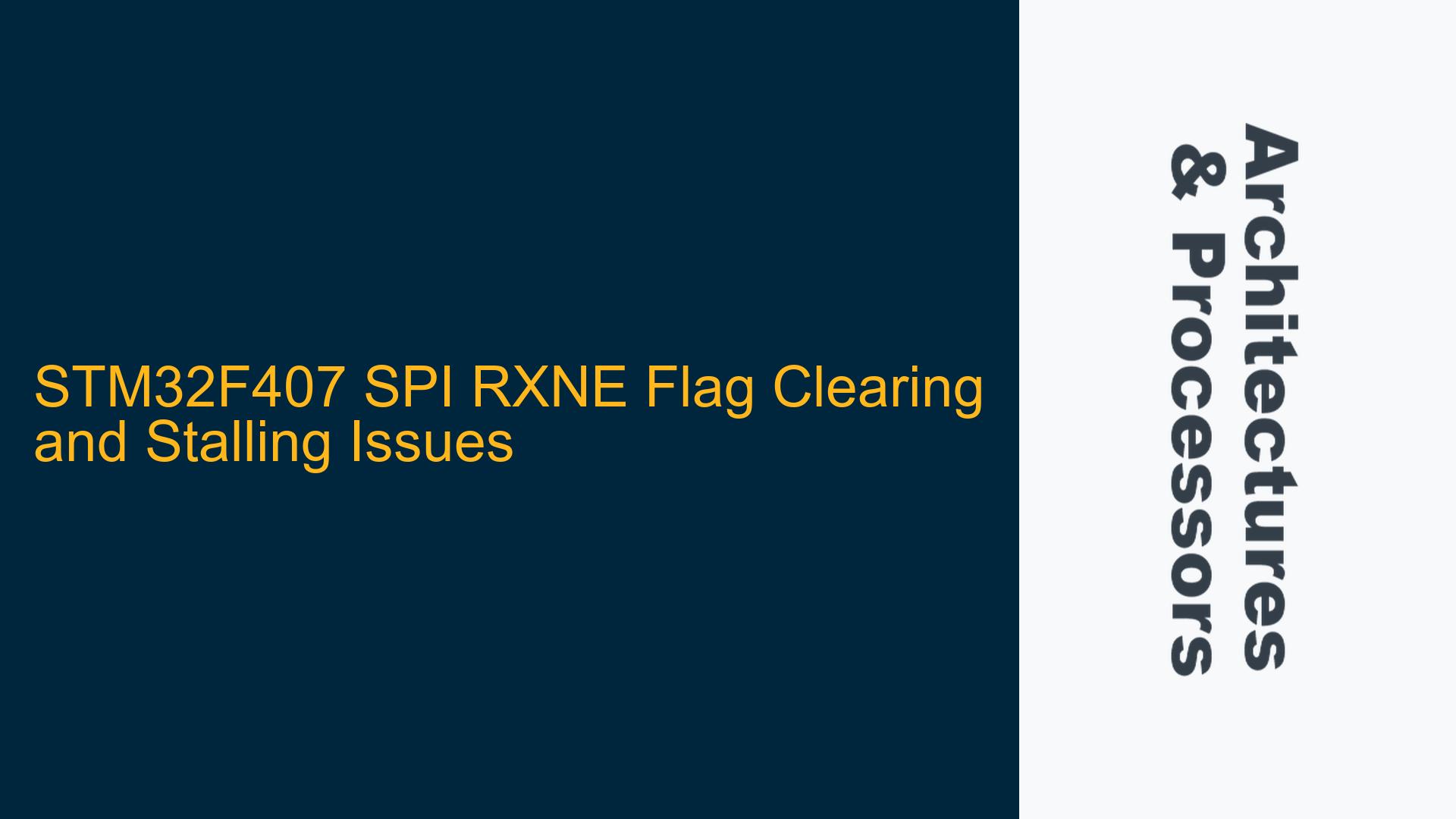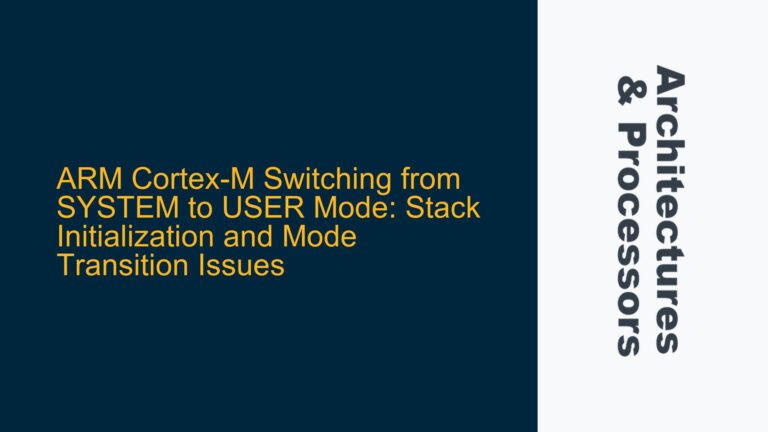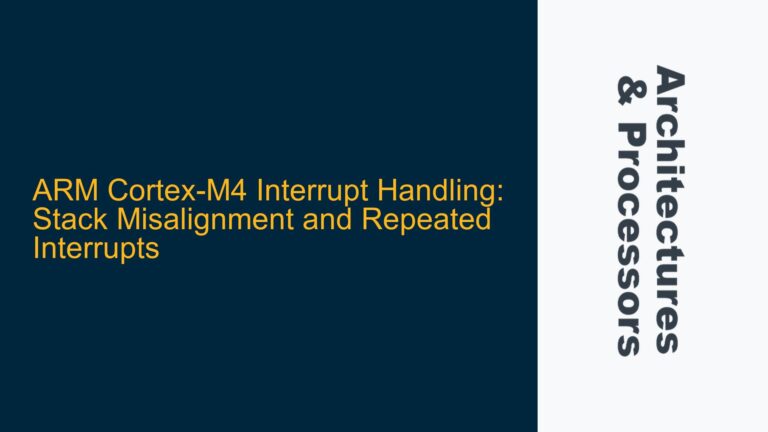SPI RXNE Flag Behavior and Stalling During Data Reception
The STM32F407 microcontroller, based on the ARM Cortex-M4 architecture, is widely used in embedded systems for its robust peripheral support, including Serial Peripheral Interface (SPI) communication. However, a common issue arises when using the SPI peripheral for data transmission and reception, specifically related to the RXNE (Receive Buffer Not Empty) flag. The RXNE flag is set when new data is received in the SPI data register (DR), indicating that the received data can be read. In some cases, developers observe that the RXNE flag is cleared unexpectedly when reading the SPI status register (SR), causing the program to stall indefinitely while waiting for the flag to be set. This behavior can be particularly perplexing during debugging, as stepping through the code may not reproduce the issue consistently.
The problem manifests in scenarios where the SPI peripheral is used for both transmitting and receiving data. For example, consider the following code snippet for SPI transmission:
void spi_transmit(uint8_t DataX) {
// Wait until the transmit buffer is empty
while(!(SPI_TFT->SR & SPI_SR_TXE));
// Write data to the data register
SPI_TFT->DR = DataX;
// Wait until the receive buffer is not empty
while(!(SPI_TFT->SR & SPI_SR_RXNE));
// Read the data register to clear the RXNE flag
SPI_TFT->DR;
// Optional: Wait until the SPI bus is not busy
// while(SPI_TFT->SR & SPI_SR_BSY);
return;
}
In this routine, the program waits for the TXE (Transmit Buffer Empty) flag to be set before writing data to the SPI data register. After writing the data, it waits for the RXNE flag to be set, indicating that data has been received. However, during execution, the program may stall at the while(!(SPI_TFT->SR & SPI_SR_RXNE)); line, even though the RXNE flag was expected to be set. This issue is exacerbated when debugging, as reading the SPI status register (SR) during debugging can inadvertently clear the RXNE flag, making it difficult to diagnose the problem.
SPI Peripheral Configuration and Timing Mismatches
The root cause of the RXNE flag clearing and stalling issue lies in the interaction between the SPI peripheral configuration, the timing of data transmission and reception, and the behavior of the status register. The SPI protocol operates in a full-duplex mode, meaning that data is transmitted and received simultaneously. When data is written to the SPI data register (DR), it is shifted out on the MOSI (Master Out Slave In) line, while data is simultaneously shifted in on the MISO (Master In Slave Out) line. The RXNE flag is set when the received data is transferred from the shift register to the data register.
One possible cause of the issue is a timing mismatch between the transmission and reception processes. If the SPI clock is not properly configured or if there is a delay in the reception process, the RXNE flag may not be set in time for the program to detect it. Additionally, the act of reading the SPI status register (SR) during debugging can clear the RXNE flag, as the read operation may inadvertently reset the flag before the program can process it.
Another potential cause is the improper handling of the SPI data register (DR). When the RXNE flag is set, the received data must be read from the data register to clear the flag. If the data register is not read in a timely manner, the RXNE flag may remain set, causing the program to stall. This is particularly problematic in systems with high SPI clock speeds or when the SPI peripheral is used in conjunction with other high-priority tasks that may delay the reading of the data register.
Furthermore, the SPI peripheral configuration, including the clock polarity (CPOL) and clock phase (CPHA) settings, can affect the timing of the RXNE flag. If the CPOL and CPHA settings are not aligned with the SPI slave device’s expectations, the received data may not be correctly synchronized, leading to issues with the RXNE flag.
Optimizing SPI Configuration and Implementing Robust Flag Handling
To address the RXNE flag clearing and stalling issue, it is essential to optimize the SPI peripheral configuration and implement robust flag handling mechanisms. The following steps outline a comprehensive approach to troubleshooting and resolving the issue:
Step 1: Verify SPI Clock Configuration
Ensure that the SPI clock is properly configured to match the requirements of the SPI slave device. The SPI clock speed should be set within the acceptable range for both the master and slave devices. Additionally, verify that the clock polarity (CPOL) and clock phase (CPHA) settings are correctly aligned with the slave device’s expectations. The CPOL and CPHA settings determine the timing of the data sampling and shifting processes, and any mismatch can lead to synchronization issues.
Step 2: Implement Proper Flag Handling
To avoid stalling due to the RXNE flag, implement a robust flag handling mechanism that ensures the flag is read and cleared in a timely manner. One approach is to use an interrupt-based mechanism to handle the RXNE flag. By enabling the SPI interrupt for the RXNE event, the program can respond to the flag as soon as it is set, reducing the likelihood of stalling. The following code snippet demonstrates how to configure the SPI interrupt for the RXNE event:
void SPI_IRQHandler(void) {
if (SPI_TFT->SR & SPI_SR_RXNE) {
// Read the data register to clear the RXNE flag
uint8_t receivedData = SPI_TFT->DR;
// Process the received data
processReceivedData(receivedData);
}
}
void spi_transmit(uint8_t DataX) {
// Wait until the transmit buffer is empty
while(!(SPI_TFT->SR & SPI_SR_TXE));
// Write data to the data register
SPI_TFT->DR = DataX;
// Enable the SPI interrupt for the RXNE event
SPI_TFT->CR2 |= SPI_CR2_RXNEIE;
return;
}
In this example, the SPI_IRQHandler function is triggered when the RXNE flag is set, allowing the program to read the data register and process the received data without stalling.
Step 3: Use Data Synchronization Barriers
To ensure that the SPI status register (SR) is read correctly and that the RXNE flag is not inadvertently cleared, use data synchronization barriers to enforce the correct order of memory accesses. Data synchronization barriers prevent the compiler and the processor from reordering memory accesses, ensuring that the status register is read before the data register. The following code snippet demonstrates the use of a data synchronization barrier:
void spi_transmit(uint8_t DataX) {
// Wait until the transmit buffer is empty
while(!(SPI_TFT->SR & SPI_SR_TXE));
// Write data to the data register
SPI_TFT->DR = DataX;
// Data synchronization barrier
__DSB();
// Wait until the receive buffer is not empty
while(!(SPI_TFT->SR & SPI_SR_RXNE));
// Read the data register to clear the RXNE flag
uint8_t receivedData = SPI_TFT->DR;
return;
}
The __DSB() function inserts a data synchronization barrier, ensuring that the status register is read before the data register.
Step 4: Debugging and Timing Analysis
When debugging the issue, use a logic analyzer or oscilloscope to monitor the SPI signals, including the clock (SCLK), MOSI, and MISO lines. This allows you to observe the timing of the data transmission and reception processes and identify any discrepancies. Additionally, use breakpoints and watchpoints in the debugger to monitor the state of the SPI status register (SR) and data register (DR) during execution. This can help identify the exact point at which the RXNE flag is cleared or stalled.
Step 5: Review SPI Peripheral Documentation
Finally, review the STM32F407 reference manual and the SPI peripheral documentation to ensure that the SPI configuration and usage align with the recommended practices. Pay particular attention to the sections on SPI status flags, data register handling, and interrupt configuration. The reference manual provides detailed information on the behavior of the SPI peripheral and can help identify any configuration errors or misunderstandings.
By following these steps, you can effectively troubleshoot and resolve the RXNE flag clearing and stalling issue in the STM32F407 SPI peripheral. Proper SPI configuration, robust flag handling, and careful debugging are key to ensuring reliable SPI communication in your embedded system.






